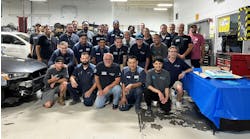Accuracy is critical when it comes to vehicle repairs. Identifying the exact problems before repairs begin is in the best interest of repair technicians and repair shops. The best way to accomplish this is to have the technician perform a vehicle electronic test prior to starting the repair process. The Automotive Service Association (ASA) is embracing the need for diagnostic scanning of all vehicles.
ASA endorsement
The ASA says they will endorse this position until the OEMs can identify the years, makes, models, and scenarios where scanning will not be necessary.
The ASA “supports full disclosure and a customers’ written acknowledgement of the diagnostic trouble codes (DTCs) identified by the scans, along with documenting and informing the customer of other issues with the vehicle that are not related to the accident but where a DTC is present.”
The ASA’s position is consistent with similar positions issued by General Motors, Audi, Honda, FCA (Chrysler), Toyota, Nissan and the Equipment and Tool institute as well as other industry associations.Identifying all trouble codes
Technicians who use the asTech™ device prior to beginning repairs, already know the value of performing a diagnostic pre-scan and post-scan. Identifying which Diagnostic Trouble Codes (DTC) were triggered helps to identify the exact damage to the vehicle before replacement parts are ordered and replaced.
When a vehicle is brought to a repair shop for repair after an accident, the technician will never know exactly which repairs will need to be completed just by looking at the vehicle. The ASA knows this, which is why they are embracing the need for pre-scans.Achieving complete repairs
Not all DTC’s are identified by a Malfunction Indicator Light (MIL), or Engine Check Light. This is why it’s so important to perform a diagnostic pre-scan before any repair work begins.
When damaged parts have been identified, disassembled, replaced and then reassembled, a post-scan with the asTech™ device is always recommended. A post scan will confirm that all repairs have been successfully completed. The ASA determines this as normal part of the repair process.




